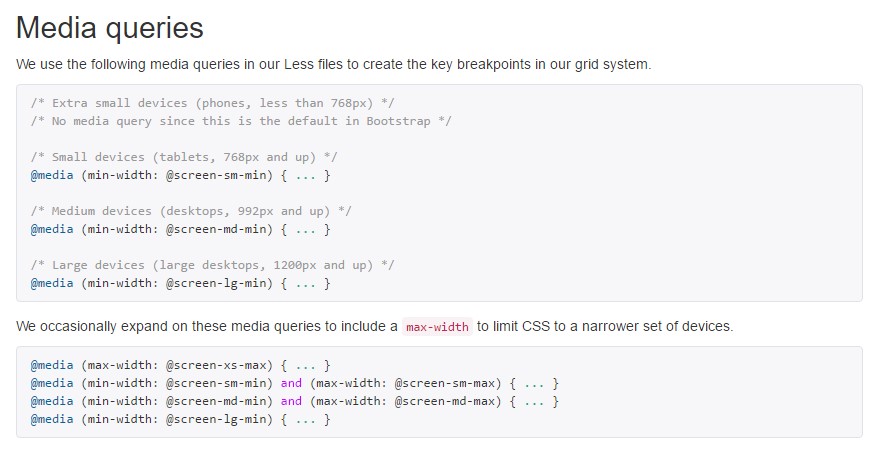Bootstrap Media queries Class
Introduction
As we said before inside the modern web that gets explored pretty much likewise simply by mobile and desktop devices getting your web pages adapting responsively to the screen they get showcased on is a requirement. That is actually why we possess the highly effective Bootstrap system at our side in its most recent 4th edition-- yet in development up to alpha 6 released at this moment.
However just what is this item under the hood that it actually applies to execute the job-- just how the page's content becomes reordered correctly and exactly what produces the columns caring the grid tier infixes like
-sm--md-The way to put into action the Bootstrap Media queries Usage:
The responsive behaviour of one of the most popular responsive system inside its most current fourth edition can operate with the help of the so called Bootstrap Media queries Class. The things they do is taking count of the size of the viewport-- the screen of the device or the size of the web browser window supposing that the page gets shown on desktop computer and employing different designing standards accordingly. So in usual words they use the easy logic-- is the size above or below a specific value-- and pleasantly activate on or off.
Each viewport dimension-- like Small, Medium and so forth has its very own media query specified except for the Extra Small display screen scale that in the latest alpha 6 release has been actually used widely and the
-xs-.col-xs-6.col-6The primary syntax
The basic syntax of the Bootstrap Media queries Grid Css inside of the Bootstrap system is
@media (min-width: ~ breakpoint in pixels here ~) ~ some CSS rules to be applied ~@media (max-width: ~ breakpoint in pixels here ~) ~ some CSS ~Another point to keep in mind
Exciting idea to observe here is that the breakpoint values for the various screen scales vary by a single pixel depending to the standard that has been simply employed like:
Small-sized screen dimensions -
( min-width: 576px)( max-width: 575px),Medium display screen dimensions -
( min-width: 768px)( max-width: 767px),Large size display screen scale -
( min-width: 992px)( max-width: 591px),And Extra large display screen dimensions -
( min-width: 1200px)( max-width: 1199px),Responsive media queries breakpoints
Given that Bootstrap is actually formed to get mobile first, we use a handful of media queries to create sensible breakpoints for designs and user interfaces . These kinds of breakpoints are primarily accordinged to minimum viewport widths as well as let us to adjust up components as the viewport changes. ( read this)
Bootstrap mostly applies the following media query varies-- or breakpoints-- in source Sass files for design, grid structure, and components.
// Extra small devices (portrait phones, less than 576px)
// No media query since this is the default in Bootstrap
// Small devices (landscape phones, 576px and up)
@media (min-width: 576px) ...
// Medium devices (tablets, 768px and up)
@media (min-width: 768px) ...
// Large devices (desktops, 992px and up)
@media (min-width: 992px) ...
// Extra large devices (large desktops, 1200px and up)
@media (min-width: 1200px) ...Since we produce source CSS in Sass, all media queries are generally obtainable through Sass mixins:
@include media-breakpoint-up(xs) ...
@include media-breakpoint-up(sm) ...
@include media-breakpoint-up(md) ...
@include media-breakpoint-up(lg) ...
@include media-breakpoint-up(xl) ...
// Example usage:
@include media-breakpoint-up(sm)
.some-class
display: block;We in some instances work with media queries which proceed in the some other course (the delivered screen dimension or more compact):
// Extra small devices (portrait phones, less than 576px)
@media (max-width: 575px) ...
// Small devices (landscape phones, less than 768px)
@media (max-width: 767px) ...
// Medium devices (tablets, less than 992px)
@media (max-width: 991px) ...
// Large devices (desktops, less than 1200px)
@media (max-width: 1199px) ...
// Extra large devices (large desktops)
// No media query since the extra-large breakpoint has no upper bound on its widthOnce more, these kinds of media queries are in addition accessible by means of Sass mixins:
@include media-breakpoint-down(xs) ...
@include media-breakpoint-down(sm) ...
@include media-breakpoint-down(md) ...
@include media-breakpoint-down(lg) ...There are in addition media queries and mixins for targeting a specific sector of display screen scales employing the minimum and highest breakpoint sizes.
// Extra small devices (portrait phones, less than 576px)
@media (max-width: 575px) ...
// Small devices (landscape phones, 576px and up)
@media (min-width: 576px) and (max-width: 767px) ...
// Medium devices (tablets, 768px and up)
@media (min-width: 768px) and (max-width: 991px) ...
// Large devices (desktops, 992px and up)
@media (min-width: 992px) and (max-width: 1199px) ...
// Extra large devices (large desktops, 1200px and up)
@media (min-width: 1200px) ...These particular media queries are in addition readily available through Sass mixins:
@include media-breakpoint-only(xs) ...
@include media-breakpoint-only(sm) ...
@include media-breakpoint-only(md) ...
@include media-breakpoint-only(lg) ...
@include media-breakpoint-only(xl) ...Additionally, media queries may well cover various breakpoint widths:
// Example
// Apply styles starting from medium devices and up to extra large devices
@media (min-width: 768px) and (max-width: 1199px) ...
<code/>
The Sass mixin for focus on the exact same screen dimension selection would definitely be:
<code>
@include media-breakpoint-between(md, xl) ...Conclusions
Do note again-- there is actually no
-xs-@mediaThis improvement is aiming to brighten both of these the Bootstrap 4's design sheets and us as developers due to the fact that it observes the regular logic of the manner responsive material functions stacking up right after a specific spot and along with the losing of the infix there certainly will be much less writing for us.
Review some online video information about Bootstrap media queries:
Linked topics:
Media queries formal documentation

Bootstrap 4: Responsive media queries breakpoints

Bootstrap 4 - Media Queries Option

